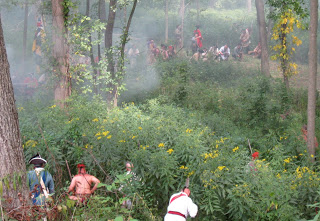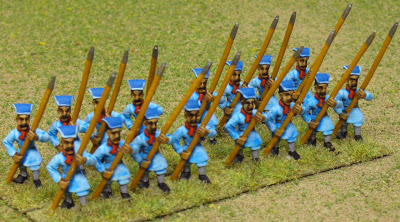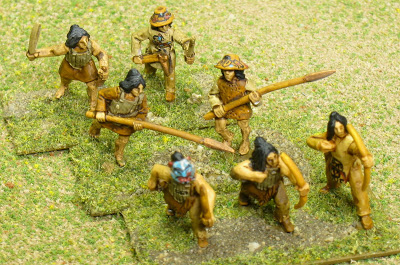Army Painter makes some interesting hobby supplies designed specifically for painting miniature wargaming armies quickly and effectively. Quickshade is a tinted varnish intended to shade painted miniatures… quickly (duh).
I’m not usually interested in using the “dip” method for painting (or shading) miniatures. But at Historicon I found a deal in the flea market I couldn’t pass up: a large painted Carthaginian army for less than the price of unpainted figures. The army is useful for killing Romans (surely a noble pursuit), but I wasn’t interested in painting Carthaginians, so it seemed like a good deal.
Unfortunately the paint job was very “old school.” There was no shading, and although most of the figures were painted with glossy enamels there were some painted in acrylics, and a variety of styles. There was obviously more than one painter at work here, though all the figures had been based somewhat uniformly. Overall it was totally not my style or preference, so I decided to try out the Army Painter quickshade to see if it would help.
I haven’t used any other “dip” formulas, so I don’t have any similar products or techniques to compare this to. I don’t intend to get good at dipping, so I wanted to get it right the first time. Army Painter was the obvious choice, since the point of this exercise was “adequacy through laziness.”
The typical use for Quickshade and other “dip” formulas is to dip the painted miniature directly into the can of varnish, remove it, and shake off the excess. This seemed very wasteful and messy to me, so I decided to use the alternate technique: apply the varnish with a brush and more carefully brush off the excess.
The first annoying thing I noticed about the Quickshade is that it is not a water based product. It’s oil based and requires mineral spirits to clean your brush, hands, spills, and so on. It’s definitely not for indoor use! I wouldn’t be able to use this while painting through long winters even if I wanted to.
Before varnishing the figures, I rebased them, touched up some chipped paint, and repainted some inappropriate colors. I tried to remove any stray dust or flock, but there were still clumps of unnaturally bright green flock glued near their feet. I decided to see what effect the quickshade would have on the flock on a few stands, before spending even more effort to clean it up.
I used a wide flat brush to apply the varnish. The process was easy, but a lot messier than I expected. The varnish has the color and consistency of used motor oil, and has a tendency to drip all over the place and get your hands quite sticky. I now think dipping and shaking could actually be less messy than brushing it on, but you’d waste a lot that way.
The most important part of appyling the product was to clean up the messy pools before they got too sticky. This was especially problematic at the bottom of flat areas such as shields.
When the varnish dried, it was as glossy as possible and looked pretty horrible to me. A topcoat of Army Painter dull spray varnish improved things considerably.
Overall, I was pleased with the results, with a few caveats.
The varnish turned the extra flock brown, at least as dark as the brown MDF bases I used. This was exactly what I was hoping for, and provided a much better color behind the new basing material, but in general you definitely don’t want to use this over flock or other loose basing material.
The Strong Tone is a dark brown, comparable to GW’s Devlan Mud wash. The color is similar, but it didn’t darken other colors as much as Devlan Mud does. It did a very good job of staying in the cracks to provide shadows, while keeping the high spots lighter.
The effectiveness of the Quickshade depends directly on the quality of the miniatures you’re shading. The figures need to have enough details for the Quickshade to creep into, or they’ll still have large areas of flat color when you’re finished. The Carthaginians were mostly old Viking Forge figures with limited detail. Most of the Gallic infantry was painted too thickly, obscuring the little detail present. Because of this, the Gauls turned out much worse than other figures with better details.
I was happy with the Quickshade’s effect over other colors, especially white. It shaded stark white into a pleasing off-white without ruining it. The shading effect is good over a wide range of colors, even typically difficult ones. It’s certainly not as nice as hand-painted shading and highlighting, but it’s an acceptable solution for a fraction of the effort.
One effect I often notice with washes or dips without additional highlighting is that the color ends up a lot deeper than you’d get if you painted lighter highlights. It’s the same deal here. Typically I paint things a bit lighter than I want them to be in the end, but in this case I didn’t have that option, so some of the colors are darker than I might otherwise prefer.
After painting approximately 54 stands of 15mm foot, infantry, and elephants (maybe 150 figures or so), well over 3/4 of the pint can of Quickshade remains. I don’t yet know how it’ll stand up to long term storage, or if it’ll start to evaporate and become too thick to use. The “dip” method wouldn’t work once you used up enough of the varnish: the figures would start to hit the bottom of the can.
The Carthaginians look much better to me than they used to (pictures should be coming soon), but they’re still definitely my “beater army.” They won’t be winning any beauty contests, but hopefully I can at least kill some Romans with them.
I won’t be putting the Army Painter Quickshade into regular use, but it will serve well for limited purposes: quick shading of figures Martine paints, and rehab of other armies I find cheap at convention flea markets.
 We arrived in the midst of the reenactment. As with most publicly viewable reenactments I’ve seen, this one seemed heavy on the show and light on accuracy (or, maybe I’m just an eternal critic who doesn’t know what he’s talking about). It seems that when you’re reenacting a specific event, it’s hard to find enough properly uniformed troops, these days. There were plenty of irregulars, but there didn’t seem to be enough properly uniformed British. Truthfully, if I were tromping through these woods I’d leave my bright red coat at home too.
We arrived in the midst of the reenactment. As with most publicly viewable reenactments I’ve seen, this one seemed heavy on the show and light on accuracy (or, maybe I’m just an eternal critic who doesn’t know what he’s talking about). It seems that when you’re reenacting a specific event, it’s hard to find enough properly uniformed troops, these days. There were plenty of irregulars, but there didn’t seem to be enough properly uniformed British. Truthfully, if I were tromping through these woods I’d leave my bright red coat at home too. Although I found the reenactment a bit disappointing, I consider that to be my fault and not theirs. The whole family thoroughly enjoyed our visit to the village, and I was able to have fun once I managed to put things into perspective. The permanent installations provided many good demonstrations of period industry and craft, and all of the reenactors looked and acted wonderful as long as I ignored the context of the massacre they attempted to demonstrate. The reenactor’s tent encampment would have been a lot more interesting to me than the reenactment itself, but since they were actually living there (for the night), it felt like a big invasion of their limited privacy even though they probably expected it. I expect the reenactors probably call us all “muggles” and complain about us behind our backs.
Although I found the reenactment a bit disappointing, I consider that to be my fault and not theirs. The whole family thoroughly enjoyed our visit to the village, and I was able to have fun once I managed to put things into perspective. The permanent installations provided many good demonstrations of period industry and craft, and all of the reenactors looked and acted wonderful as long as I ignored the context of the massacre they attempted to demonstrate. The reenactor’s tent encampment would have been a lot more interesting to me than the reenactment itself, but since they were actually living there (for the night), it felt like a big invasion of their limited privacy even though they probably expected it. I expect the reenactors probably call us all “muggles” and complain about us behind our backs.











